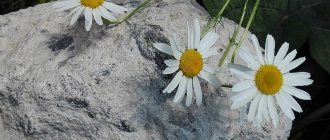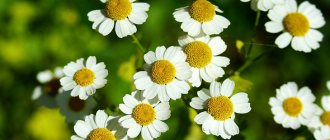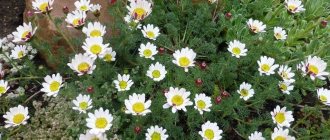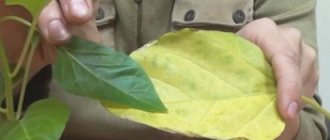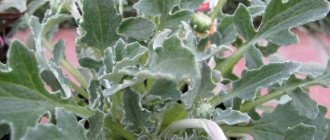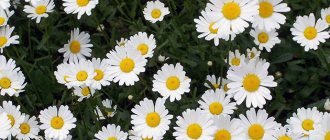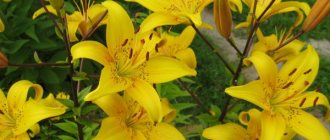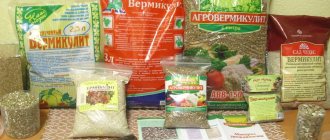Chamomiles are plants of the Compositaceae genus, which, depending on the species, may differ in flower height, size of inflorescences and flowering period. There is a certain variety of types of this flower, and the most popular include: pyrethrum, pyrethrum, doronicum, small petal.
- Pyrethrum – The petals of this chamomile can be red, pink or yellow. In structure they can be simple or terry. This type of daisy grows more than one meter and prefers to grow in sunny areas in well-drained soils. The dried petals of this plant are useful; they are effective in fighting moths.
- Nivyanik - this type of chamomile is also called popnika or large garden chamomile. The middle of the flower is invariably yellow, and the petals can be either simple, semi-double or double, the size of the flowers can be small and medium. This plant will benefit greatly from fertilization and frequent watering.
- Small petal - prefers loose soils, and the place where it grows is sunny. This type of chamomile blooms from late June to August. The height of this plant is about one meter. Petals can be colored pink, white, purple and blue.
- Doronicum is an unpretentious type of chamomile. Grows in both sun and slight shade. It grows a little over half a meter in height. It blooms from May to June, the flowers are quite large in size.
Doronicum
What kind of flower
Doronicum is a perennial herbaceous plant with stem-embracing alternate and basal leaves. Shoots are formed in the stem axils, on which buds are formed. The flowers also grow on long stalks. The height of Doronicum depends on the variety: there are dwarf varieties (10-15 cm) and tall varieties (140-150 cm). The rhizome is tuberous, superficially located. The fruit is an achene.
Yellow daisies belong to the Asteraceae family. Along with ratibida columnarum, similar in color to doronicum, the plant is often called the prairie flower. However, the hardy perennial is able to take root not only on the plains. It is distributed in European mountain ranges and can settle at an altitude of 3500 m above sea level.
Interesting to know. The name "doronicum" comes from the Arabic word "doronish", which denoted an unknown poisonous plant. In Russia, the bright flower is more often called Kozulnik.
Description and types of yellow perennial chamomile
The genus Chamomile has a common botanical name Matricaria, which can be translated as mother herb. The genus includes about 20 species. The most widely known are chamomile and chamomile chamomile, also known as fragrant chamomile. As a rule, all daisies are perennial flowering herbaceous plants.
Wild chamomiles are very widespread. On the territory of the country they are found in the European part, in Siberia, and in the Far East. Most often, the height of the stems of daisies is from 15 to 60 cm. The leaves of daisies are pinnate or pinnately dissected. There are two types of flowers - tubular median and marginal false-lingulate.
It should be noted that the descriptions of neither fragrant chamomile nor chamomile fall under the usual description of large white-yellow flowers. If we are talking specifically about daisies, then some varieties of exceptional chamomile or exceptional matricaria can be considered yellow perennial chamomile:
- Goldbal - double inflorescences in the shape of a ball of tubular flowers, round, spherical in shape with a diameter of 20 - 25 mm, yellow-cream color, no reed flowers
- Golden Ball - yellow or yellow-orange inflorescences, 30 mm in diameter, shoot height up to 35 cm
Despite the fact that these species belong to the genus Chamomile, in appearance they are unlike those plants to which this name is popularly assigned. It is more common to call yellow chamomile the perennial Nivyanika variety with yellow colored reed flowers. These varieties include:
- Banana cream - the inflorescences are semi-double, the reed flowers are yellow after blooming, followed by fading to ivory color, while the middle remains a rich egg yolk color, the diameter of the inflorescences is up to 10 cm.
- Goldfinch - double and semi-double flowers with golden-yellow narrow reed flowers, arranged around a yellow center formed by tubular flowers, stem height 0.4 - 0.6 m.
Important! Despite the differences, the Matricaria varieties and the yellow inflorescence varieties belong to the same Asteraceae family and have the same cultivation techniques. All plants that can be classified as perennial yellow daisies are not very demanding to care for. They can be planted and grown quite easily on the site yourself.
Interesting varieties
Perennial Gladioli flowers - description
In total there are about 40 varieties of Doronicum. 12 of them grow in Russia, only a few are particularly popular.
Oriental
Doronicum Orientale Hoffing can also be called Caucasian. This is the most common inhabitant of Russian gardens. Under natural conditions, it is most common in the Caucasus and the Mediterranean.
Eastern Doronicum
The height of the plant is approximately 50 cm. The roots are tuberous and lie close to the soil surface. The basal leaves are serrated, petiolate, stem, ovate, sessile. Yellow flowers bloom in mid-May; the flowering period lasts about a month. Afterwards, the above-ground parts of the yellow chamomile die off. The new green outlet will appear only at the end of summer.
The species was cultivated in 1808. The most common varieties are Spring Beauty, Gold Dwarft, Little Leo. All are low-growing, compact, and highly decorative.
Plantain
Plantain doronicum (Doronicum Plantagineum) is distinguished by slightly pubescent leaves and trunks. It is larger than its Caucasian relative (up to 140 cm in height), forms large inflorescences, and blooms 7-10 days later. It grows naturally in western Europe.
Plantain variety
The most popular varieties include Miss Mason, Harpuf Crewe.
Austrian
Austrian doronicum (Doronicum Austriacum Jacq) is distinguished by its medium height (up to 70 cm) and bright flowers with an orange center.
Austrian roe
The ornamental plant blooms in August.
Description of varieties bred from pure Doronicum
Perennial gladioli flowers - description
Based on this variety, many beautiful varieties have been bred.
Doronicum eastern
Herbaceous perennial plant, half a meter tall. Places of growth - the Caucasus, the Mediterranean and Asia Minor. The ovate basal foliage with long petioles is serrated along the edges. The diameter of the pale yellow flowers is 3-5 cm. The core has a brighter, golden hue.
Doronicum eastern
Doronicum plantain
The height of the plant reaches one and a half meters. On strong, slightly branched shoots there is oval, dark green foliage. The foliage is serrated.
Doronicum plantain
Cluse
Habitat: high alpine meadows. The height of the plant is up to 30 cm. The jagged foliage is covered with cilia and thick pile. At the pubescent top there is a bright yellow basket. The diameter of the flowers is 3-6 cm.
Doronicum Clews
Growing from seeds
Ampelous unpretentious perennial flowers for the garden
Before you start growing Doronicum from seeds, you need to decide when to plant the plant and how to care for it. It is not difficult to obtain healthy, profusely blooming yellow daisies, thanks to the unpretentiousness of the flower.
Note! Kozulnik tends to reproduce by self-sowing.
Seedling
The seedling method is a little more troublesome than planting seeds directly into the ground. However, it gives better results.
It is best to start sowing to obtain seedlings in April. For sowing, select a container with cells that are filled with nutrient substrate (1 part peat and coarse sand each). Sow 2-3 seeds per cell and sprinkle with water. The container is covered with glass or film and placed in a bright place, protected from direct sunlight. Further care consists of daily ventilation of the plantings and periodic moistening of the soil with a spray bottle.
Seedless method
Sowing directly into open ground is carried out from mid-April, when the air temperature reaches 16°C, or in late autumn.
Approximately 2 weeks before sowing, it is necessary to prepare the land. They dig it up onto the bayonet of a shovel and carefully break up the lumps. When the soil settles, shallow (1-2 cm) grooves are made in it. The distance between the rows must be at least 20 cm. The plantings must be shed with water. The seedlings sprout amicably and abundantly, so after their appearance you will have to thin out. There should be at least 7 cm of space between adjacent plants. When the height of young plants reaches 10 cm, it is time to plant them in permanent places. The interval between two adjacent seedlings is 25 cm.
Basic growing rules
Perennial phloxes: planting and care in open ground
The main points associated with planting seedlings in the ground and subsequent care for them are very important for obtaining beautiful, healthy plants.
Planting container and soil
For planting seedlings, you can use not only cellular containers, but also boxes, pots and cups. The main thing is to keep your distance without thickening the planting. As a nutrient substrate, it is enough to take a mixture of peat with humus or store-bought universal soil.
The right time to sow
Sowing of seedlings is carried out in early April, young plants are placed in open ground in early June.
Soil cutting
Mid-November or April is suitable for planting in the garden before winter.
Site selection and soil preparation
The main requirement for soil is lightness and looseness. To prevent the seeds from falling through, you have to wait until they shrink after digging. If the soil is depleted, you can add rotted manure into the beds while digging.
Important! Since the plant has a shallow root system, there is no need to loosen the soil underneath too deeply.
Material preparation and sowing
Yellow chamomile seeds remain viable for 2 years. They actively germinate once they get into the soil, so the seedlings will have to be thinned out. Since seed material, when properly stored, is resistant to damage and spoilage, no special preparatory procedures are required.
How to care for seedlings
With the seedling growing method, seedlings appear a couple of weeks after sowing. At this time, the cover from the container is removed and the plants are moved to a brighter place. If the weather is not favorable with sunny days, it is recommended to supplement the seedlings with a phytolamp.
To make the plants more magnificent, in the phase of the 3rd leaf it is necessary to pinch their tops.
Landing in the ground
A week before planting (at the end of May), it is time to take the seedlings out into the open air for hardening, first for an hour, gradually increasing the time to a day.
How to plant seedlings:
- Dig the area 20-25 cm deep. Add rotted manure;
- Dig planting holes of such a size that they can accommodate the root with a ball of earth. The distance between the holes should be at least 0.4 m, because Doronicum grows greatly;
- Plant the plants in the holes, gently press the soil at the roots and water generously with cool water.
Note! Kozulnik is also grown as a houseplant, but only dwarf varieties are suitable for this.
Features of planting and caring for crops
Yellow chamomile is a rather unpretentious flower; it can be sown directly into the ground with seeds. In spring, sowing can be done from May, in autumn - in October. However, to be on the safe side for the first time, you can grow seedlings this way:
- in February-March, sow seeds in the soil (universal, you can add sand or peat);
- monitor lighting and regular watering of seedlings;
- when three leaves appear, you need to pick;
- in May, young flowers should have five leaves.
Tomato Caramel yellow
Chamomile should be planted in places well lit by the sun. The soil suitable for this plant should be slightly alkaline and loose. Make 20 cm depressions in the soil for each plant, then plant them using the transshipment method. Be sure to water.
Two weeks after planting, chamomile can be fed with mineral fertilizers. Further maintenance is simple: watering, removing weeds, loosening the soil. Yellow chamomile is frost-resistant, but this is a property of mature plants. And for the first two years, it is better to cover young ones for the winter with additional dry grass and leaves.
Chamomile can be propagated by cuttings and rhizomes.
Important! It is necessary to divide adult bushes 5 years after planting so that the flowers do not become smaller in size. By dividing into small bushes, the plant rejuvenates.
Dividing the bush into several is carried out in the fall after flowering. A large bush is divided into equal parts along with the root. Then the new bushes are transplanted into the prepared soil and fertilizing is applied. Yellow chamomile can also be propagated by cuttings, although this is a less common method.
Additional attention to the plant will benefit:
- timely removal of faded flowers;
- regular watering and weeding;
- Mulching the soil is encouraged: in a thin layer in summer, up to 20 cm in winter.
Mulching protects flowers from the growth of weeds and drying out of the soil, and retains moisture.
After the end of the growing season, the chamomile is cut off (all the above-ground parts).
In order for flowers to bloom long and profusely, you need to feed them periodically:
- at the beginning of flowering, nitrophoska fertilizer is suitable;
- after flowering immediately with potassium and superphosphate;
- It is recommended to add ash to the soil in the fall to prevent pests.
Outdoor care
With a plant such as Doronicum, planting and care are not difficult. The flower is unpretentious and withstands weather anomalies.
Watering
Doronicum should be watered regularly, since the root system, located near the surface, cannot take moisture from the deep layers of the soil. It is better to use settled water. To prevent the soil from drying out longer, it is recommended to mulch it with sawdust.
Spraying
In hot weather, the plant will benefit from evening spraying or sprinkling. There is no need to be too zealous with watering, so as not to provoke disease. Yellow daisies do not like excess humidity and shade, so it is better not to place them under large trees or in lowlands.
Priming
Kozulnik does not like acidic, clayey, heavy soils. Most likely, the hardy plant will not die, but will grow small, weak, with small flowers. The best option is light, loose, slightly acidic soil with a sufficient amount of nutrients.
Feeding
In spring, the plant can be pampered with complex fertilizers; the flower responds equally well to both mineral compounds and organic matter. At the end of summer, when new rosettes are growing, it would not be a bad idea to feed the roe grass with nitrogen-containing compounds.
How to choose a flower that looks like a daisy?
Among the listed variety, every daisy lover will find a suitable option. The choice depends on the properties of the varieties, preferences in colors and plant size. Chamomile-like flowers come in different colors, heights and even types (grass, shrubs) . They are selected for any ensemble in a flowerbed and they will last for many years, delighting with bright colors and long-lasting flowering.
Garden chamomile is one of the most famous and popular flowers among gardeners. The genus of Daisies has approximately 20 species and many varieties. One of them is very unusual and attractive - yellow daisy. The bright and delicate color of this flower, combined with greenery, presents a sight of amazing beauty and lifts your spirits.
When and how does it bloom
Doronicum is a flower that can change the size of its petals and color intensity depending on weather conditions. In general, the flowers look like small daisies, which is why they are often confused with pyrethrum. The color of the petals is bright yellow, the middle can be darker, even brown. The diameter of the inflorescences varies from 4 to 15 cm, depending on the variety.
Doronicum flowering
Flowering begins in spring and lasts all summer. Cut Doronicum flowers can stand in water for up to 14 days, maintaining a fresh appearance.
Propagate by seeds and dividing the bush
Dividing the bush
| |
Seeds
|
Possible problems in growing
Although yellow chamomile is a hardy plant, there are still problems with its cultivation. They can be solved by using special products and adjusting your care regimen.
Pests
The ubiquitous aphids and thrips do not ignore the yellow chamomile. Small sap-sucking insects do not cause significant harm at first. But, having multiplied, they are capable of leading Doronicum to death.
There are many different insecticides that successfully control parasites. It is enough to treat the plantings according to the instructions, and small parasites will not be scary for the garden “suns”.
Sometimes slugs climb onto the plant and eat the foliage. To prevent their appearance, just sprinkle the soil around the flower with hot ground pepper. The sensitive abdomen will not allow harmful creatures to overcome the barrier.
Diseases
Gray rot appears on plants in thickened plantings, with excessive watering. It is advisable to thin out the plants, remove infected parts and adjust the watering regime.
Rust and powdery mildew also most often attack waterlogged plantings. In this case, watering must be reduced and damaged parts of the plant removed. Spray doronicum with Topaz or another preparation with a similar effect.
Signs of improper care
Doronicum can produce small flowers if it has not been planted for a long time. To rejuvenate, the plant is dug up and divided into parts. The new flowers on the updated gooseberry will be noticeably larger. Another growing problem is excess light. When placing a plant on a site, it is worth remembering that although Doronicum is light-loving, excessive exposure to the sun's rays provokes the crushing of flowers.
Kozulnik on the site
Planting and caring for doronicum in open ground is extremely simple. Even a beginner can cope with them, who will be doubly pleased to enjoy the bright flowering of a garden favorite.
Diseases and pests
| Powdery mildew Control measures:
| |
| Rust Control measures:
| |
| Root nematode Control measures:
| |
| Aphid Control measures:
|

